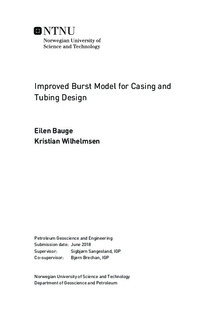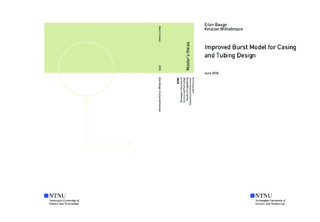| dc.description.abstract | Casing and tubing design for burst are performed by requiring a safety margin against yield under internal overpressure. Today's design process uses design limit plots, consisting of Barlow's and the approximate von Mises equation. Embedded in the strength formulas are a wall tolerance factor of 12.5 %, which was introduced in the 1960 s due to the inaccuracy in the casing manufacturing process. Unnecessary steel costs are generated by these conservative assumptions and old-fashioned theories. The goal of this thesis was to investigate theories from the literature to develop a more up to date engineering model for designing casing and tubing against burst.
The improved burst model removes Barlow's uniaxial equation, as it was found to obsolete for its theoretical background and for its lack of validity. The approximate von Mises ellipse is replaced with the exact ellipse, to include external pressure. The model also allows the wall tolerance to be specified, as the manufacturing process has improved since the 1960's. Most importantly, ductile rupture is included, to visualise the actual pressure required to rupture the pipe. Comparing the more accurate yield with the limit for loss of pressure integrity, opens up for a much better understanding of the burst tolerance.
The results showed that the ductile rupture formula predicts loss of pressure integrity accurately, when compared to measured rupture pressure. A mean difference and standard deviation of - 0.44 % and 4.48 % respectively, was observed.
The case study performed showed that a shallow water well with a low casing grade resulted in a large plasticity zone. The new design methodology reduced the steel weight from 40 ppf to 36 ppf. For a midwater well, with a small plasticity zone, no weight reduction was recommended. The improved burst model allowed the steel weight to reduce from 59.4 ppf to 53.5 ppf for a deepwater well.
The results from the improved burst model are presented such that the industry can start to implement the cost-saving measures immediately. Before the ductile rupture equation is used, more tests including axial stress and external pressure should be performed. | en |

